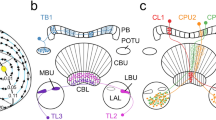Summary
Polarized light from the blue sky exhibits an extensive pattern which in terms of both direction and degree of polarization is linked to the position of the sun (Fig. 1). Honeybees, among other animal species, are able to perceive skylight polarization and to use it as compass in both foraging flights and communication dances.
-
1.
From our previous work it is known that bees orient by means of a simplified e-vector map when their view of the sky is restricted to single e-vector directions (Fig. 2). Nothing is known, however, regarding how navigating bees analyse the polarization pattern as a whole.
-
2.
To study this, dancing bees were presented large parts of the natural e-vector patterns, and their orientation performance with respect to known feeding stations was analysed (Fig. 4A, 5A, 6A).
-
3.
The results show that bees make mistakes, and these are consistent with the hypothesis that they invariably apply their simplified e-vector map to any polarization pattern they are exposed to (Figs. 3, 4B, 5B, 6B).
-
4.
Based on these findings it is suggested that information processing in the bee's visual system does not elaborate a detailed image of the polarization patterns. Rather, it is hypothesized, a simplified version of the pattern, as the one deduced experimentally (Fig. 2), is determined and mimicked by the spatial layout of polarization analysers in the bee's retina (Fig. 7). For the model to work, the insect then has to rotate about its vertical body axis and in doing so perceives celestial polarization in the form of temporal brightness and/or colour modulations (Fig. 8).
-
5.
It is explained how the bee could use these modulations to derive the orientation of the celestial sphere and subsequently the direction of the intended compass course.
Similar content being viewed by others
References
Bernard GD, Wehner R (1977) Functional similarities between polarization vision and colour vision. Vision Res 17:1019–1028
Brines ML, Gould JL (1982) Skylight polarization patterns and animal orientation. J Exp Biol 96:69–91
Coulson KL, Dave JV, Sekera Z (1960) Tables related to radiation emerging from planetary atmosphere with really scattering. Univ Press, Berkeley, California
Frisch K von (1949) Die Polarisation des Himmelslichtes als orientierender Faktor bei den Tänzen der Bienen. Experientia 5:142–148
Frisch K von (1967) The dance language and orientation of bees. Harvard University Press, Cambridge, Massachusetts
Glas H van der (1975) Polarization induced colour patterns: a model of the perception of the polarized skylight by insects. I. Tests in choice experiments with running honey bees,Apis mellifera. Neth J Zool 25:476–505
Glas H van der (1976) Polarization induced colour patterns: a model of the perception of the polarized skylight by insects. II. Experiments with direction trained dancing bees,Apis mellifera. Neth J Zool 26:383–413
Glas H van der (1980) Orientation of bees,Apis mellifera, to unpolarized colour patterns, simulating the polarized zenith skylight pattern. J Comp Physiol 139:225–241
Heiversen O von, Edrich W (1974) Der Polarisationsempfänger im Bienenauge: ein Ultraviolettrezeptor. J Comp Physiol 94:33–47
Kirschfeld K (1972) Die notwendige Anzahl von Rezeptoren zur Bestimmung der Richtung des elektrischen Vektors linear polarisierten Lichtes. Z Naturforsch 27b:578–579
Labhart T (1980) Specialized photoreceptors at the dorsal rim of the honeybee's compound eye: polarizational and angular sensitivity. J Comp Physiol 14:19–30
Rossel S, Wehner R, Lindauer M (1978) E-vector orientation in bees. J Comp Physiol 125:1–12
Rossel S, Wehner R (1982) The bee's map of the e-vector pattern in the sky. Proc Natl Acad Sci USA 79:4451–4455
Sekera Z (1956) Recent development in the study of the polarization of skylight. Adv Geophys 3:43–103
Waterman TH (1981) Polarization sensitivity. In: Autrum H (ed) Handbook of sensory physiology, vol. VII/6B. Springer, Berlin Heidelberg New York, pp 281–470
Wehner R (1982) Himmelsnavigation bei Insekten. Neurophysiologie und Verhalten. Neujahrsbl Naturforsch Ges Zürich 194
Wehner R (1983) The perception of polarized light. In: Cosens D, Vince-Prue D (eds). The biology of photoreceptors. Cambridge University Press, Cambridge London, pp 331–369
Wehner R, Bernard GD, Geiger E (1975) Twisted and nontwisted rhabdoms and their significance for polarization detection in the bee. J Comp Physiol 104:225–245
Wehner R, Rossel S (1983) Polarized light navigation in bees: use of zenith and off-zenith e-vectors. Experientia 39:642
Author information
Authors and Affiliations
Rights and permissions
About this article
Cite this article
Rossel, S., Wehner, R. How bees analyse the polarization patterns in the sky. J. Comp. Physiol. 154, 607–615 (1984). https://doi.org/10.1007/BF01350213
Accepted:
Issue Date:
DOI: https://doi.org/10.1007/BF01350213



